DkIT Midwifery Case Study: Neonatal Care and Attachment Process
VerifiedAdded on 2022/09/06
|13
|3611
|31
Case Study
AI Summary
This case study presents a reflective analysis from a clinical practitioner's perspective, focusing on the critical aspects of mother-infant bonding and care within a midwifery context. The paper explores the facilitation of baby bathing techniques, highlighting the importance of proper procedures and the sensitive nature of newborn skin. It then delves into Bowlby's attachment theory, explaining how newborns develop attachments through interactions like bathing. Furthermore, the study examines the benefits of kangaroo contact (skin-to-skin) for fostering attachment, maternal confidence, and breastfeeding success. The paper discusses the practical application of kangaroo care, including proper positioning and the emotional support needed for mothers. The case study also considers the impact of these interventions on infant development and the role of nurses in supporting the mother-infant dyad, referencing the importance of early interactions and the benefits of breastfeeding and touch for the newborn. The case study concludes by emphasizing the significant impact of these practices on promoting healthy development and reducing the stress associated with birth.

Running head: NURSING
NURSING
Name of the Student:
Name of the University:
Author note:
NURSING
Name of the Student:
Name of the University:
Author note:
Paraphrase This Document
Need a fresh take? Get an instant paraphrase of this document with our AI Paraphraser
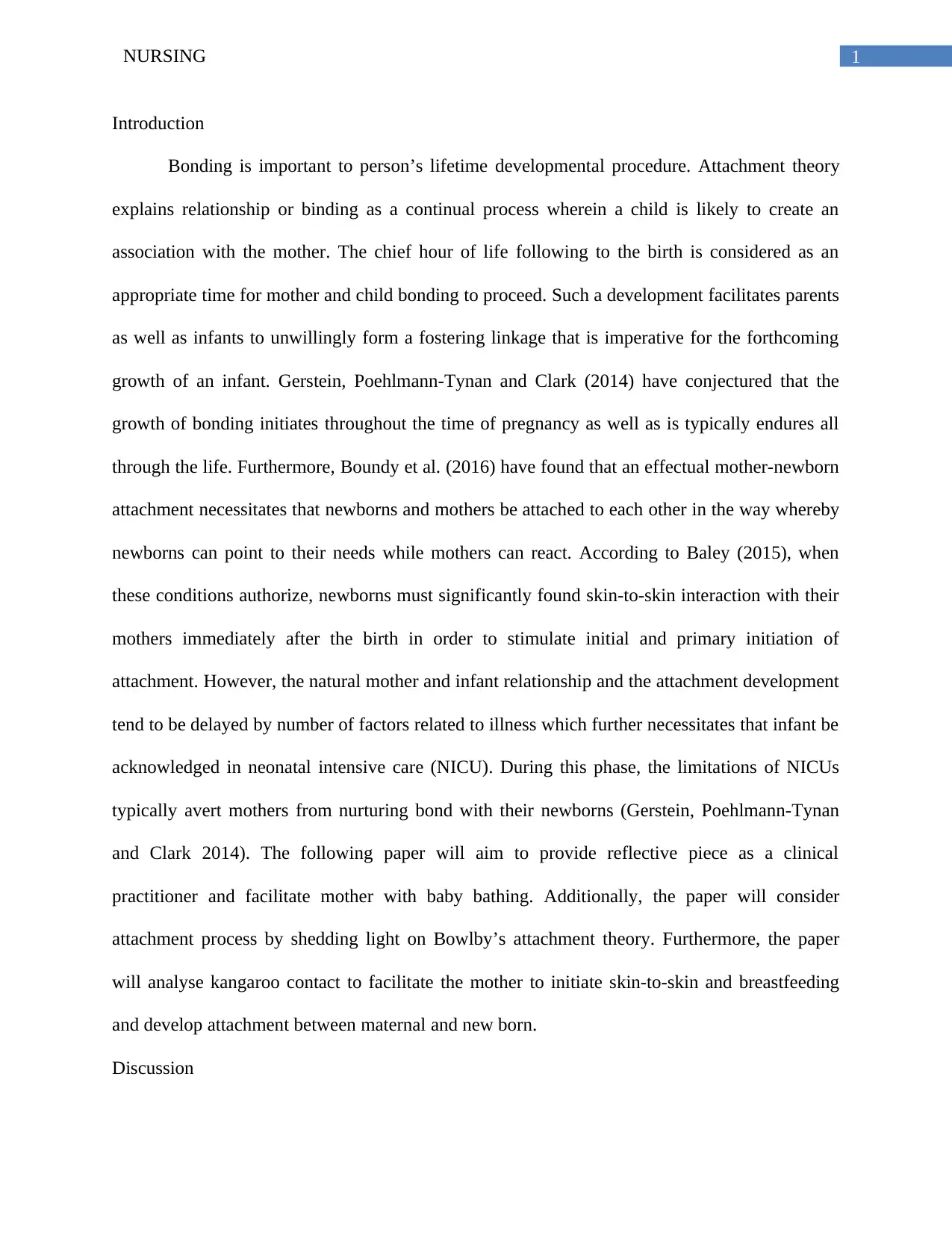
1NURSING
Introduction
Bonding is important to person’s lifetime developmental procedure. Attachment theory
explains relationship or binding as a continual process wherein a child is likely to create an
association with the mother. The chief hour of life following to the birth is considered as an
appropriate time for mother and child bonding to proceed. Such a development facilitates parents
as well as infants to unwillingly form a fostering linkage that is imperative for the forthcoming
growth of an infant. Gerstein, Poehlmann-Tynan and Clark (2014) have conjectured that the
growth of bonding initiates throughout the time of pregnancy as well as is typically endures all
through the life. Furthermore, Boundy et al. (2016) have found that an effectual mother-newborn
attachment necessitates that newborns and mothers be attached to each other in the way whereby
newborns can point to their needs while mothers can react. According to Baley (2015), when
these conditions authorize, newborns must significantly found skin-to-skin interaction with their
mothers immediately after the birth in order to stimulate initial and primary initiation of
attachment. However, the natural mother and infant relationship and the attachment development
tend to be delayed by number of factors related to illness which further necessitates that infant be
acknowledged in neonatal intensive care (NICU). During this phase, the limitations of NICUs
typically avert mothers from nurturing bond with their newborns (Gerstein, Poehlmann-Tynan
and Clark 2014). The following paper will aim to provide reflective piece as a clinical
practitioner and facilitate mother with baby bathing. Additionally, the paper will consider
attachment process by shedding light on Bowlby’s attachment theory. Furthermore, the paper
will analyse kangaroo contact to facilitate the mother to initiate skin-to-skin and breastfeeding
and develop attachment between maternal and new born.
Discussion
Introduction
Bonding is important to person’s lifetime developmental procedure. Attachment theory
explains relationship or binding as a continual process wherein a child is likely to create an
association with the mother. The chief hour of life following to the birth is considered as an
appropriate time for mother and child bonding to proceed. Such a development facilitates parents
as well as infants to unwillingly form a fostering linkage that is imperative for the forthcoming
growth of an infant. Gerstein, Poehlmann-Tynan and Clark (2014) have conjectured that the
growth of bonding initiates throughout the time of pregnancy as well as is typically endures all
through the life. Furthermore, Boundy et al. (2016) have found that an effectual mother-newborn
attachment necessitates that newborns and mothers be attached to each other in the way whereby
newborns can point to their needs while mothers can react. According to Baley (2015), when
these conditions authorize, newborns must significantly found skin-to-skin interaction with their
mothers immediately after the birth in order to stimulate initial and primary initiation of
attachment. However, the natural mother and infant relationship and the attachment development
tend to be delayed by number of factors related to illness which further necessitates that infant be
acknowledged in neonatal intensive care (NICU). During this phase, the limitations of NICUs
typically avert mothers from nurturing bond with their newborns (Gerstein, Poehlmann-Tynan
and Clark 2014). The following paper will aim to provide reflective piece as a clinical
practitioner and facilitate mother with baby bathing. Additionally, the paper will consider
attachment process by shedding light on Bowlby’s attachment theory. Furthermore, the paper
will analyse kangaroo contact to facilitate the mother to initiate skin-to-skin and breastfeeding
and develop attachment between maternal and new born.
Discussion
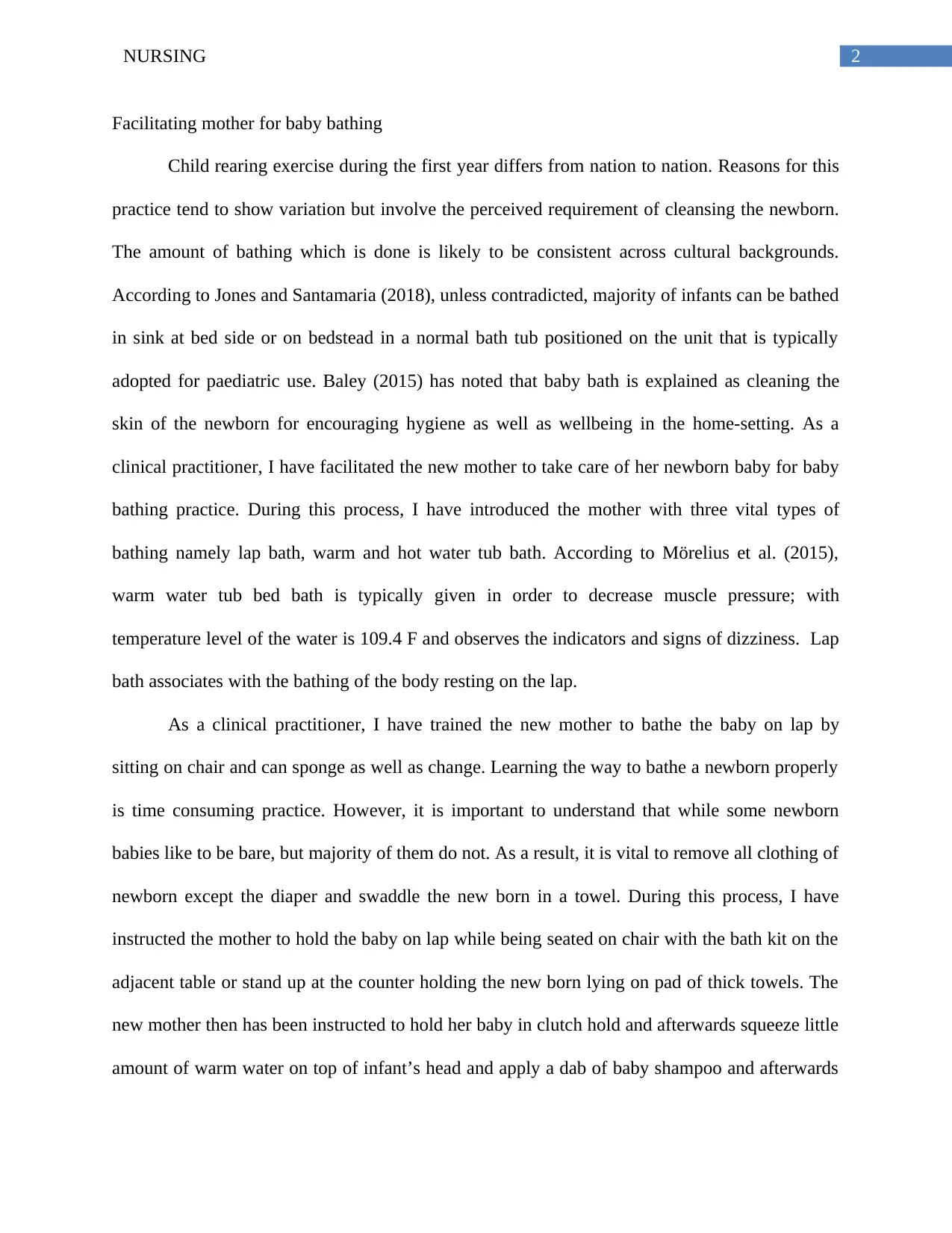
2NURSING
Facilitating mother for baby bathing
Child rearing exercise during the first year differs from nation to nation. Reasons for this
practice tend to show variation but involve the perceived requirement of cleansing the newborn.
The amount of bathing which is done is likely to be consistent across cultural backgrounds.
According to Jones and Santamaria (2018), unless contradicted, majority of infants can be bathed
in sink at bed side or on bedstead in a normal bath tub positioned on the unit that is typically
adopted for paediatric use. Baley (2015) has noted that baby bath is explained as cleaning the
skin of the newborn for encouraging hygiene as well as wellbeing in the home-setting. As a
clinical practitioner, I have facilitated the new mother to take care of her newborn baby for baby
bathing practice. During this process, I have introduced the mother with three vital types of
bathing namely lap bath, warm and hot water tub bath. According to Mörelius et al. (2015),
warm water tub bed bath is typically given in order to decrease muscle pressure; with
temperature level of the water is 109.4 F and observes the indicators and signs of dizziness. Lap
bath associates with the bathing of the body resting on the lap.
As a clinical practitioner, I have trained the new mother to bathe the baby on lap by
sitting on chair and can sponge as well as change. Learning the way to bathe a newborn properly
is time consuming practice. However, it is important to understand that while some newborn
babies like to be bare, but majority of them do not. As a result, it is vital to remove all clothing of
newborn except the diaper and swaddle the new born in a towel. During this process, I have
instructed the mother to hold the baby on lap while being seated on chair with the bath kit on the
adjacent table or stand up at the counter holding the new born lying on pad of thick towels. The
new mother then has been instructed to hold her baby in clutch hold and afterwards squeeze little
amount of warm water on top of infant’s head and apply a dab of baby shampoo and afterwards
Facilitating mother for baby bathing
Child rearing exercise during the first year differs from nation to nation. Reasons for this
practice tend to show variation but involve the perceived requirement of cleansing the newborn.
The amount of bathing which is done is likely to be consistent across cultural backgrounds.
According to Jones and Santamaria (2018), unless contradicted, majority of infants can be bathed
in sink at bed side or on bedstead in a normal bath tub positioned on the unit that is typically
adopted for paediatric use. Baley (2015) has noted that baby bath is explained as cleaning the
skin of the newborn for encouraging hygiene as well as wellbeing in the home-setting. As a
clinical practitioner, I have facilitated the new mother to take care of her newborn baby for baby
bathing practice. During this process, I have introduced the mother with three vital types of
bathing namely lap bath, warm and hot water tub bath. According to Mörelius et al. (2015),
warm water tub bed bath is typically given in order to decrease muscle pressure; with
temperature level of the water is 109.4 F and observes the indicators and signs of dizziness. Lap
bath associates with the bathing of the body resting on the lap.
As a clinical practitioner, I have trained the new mother to bathe the baby on lap by
sitting on chair and can sponge as well as change. Learning the way to bathe a newborn properly
is time consuming practice. However, it is important to understand that while some newborn
babies like to be bare, but majority of them do not. As a result, it is vital to remove all clothing of
newborn except the diaper and swaddle the new born in a towel. During this process, I have
instructed the mother to hold the baby on lap while being seated on chair with the bath kit on the
adjacent table or stand up at the counter holding the new born lying on pad of thick towels. The
new mother then has been instructed to hold her baby in clutch hold and afterwards squeeze little
amount of warm water on top of infant’s head and apply a dab of baby shampoo and afterwards
⊘ This is a preview!⊘
Do you want full access?
Subscribe today to unlock all pages.

Trusted by 1+ million students worldwide
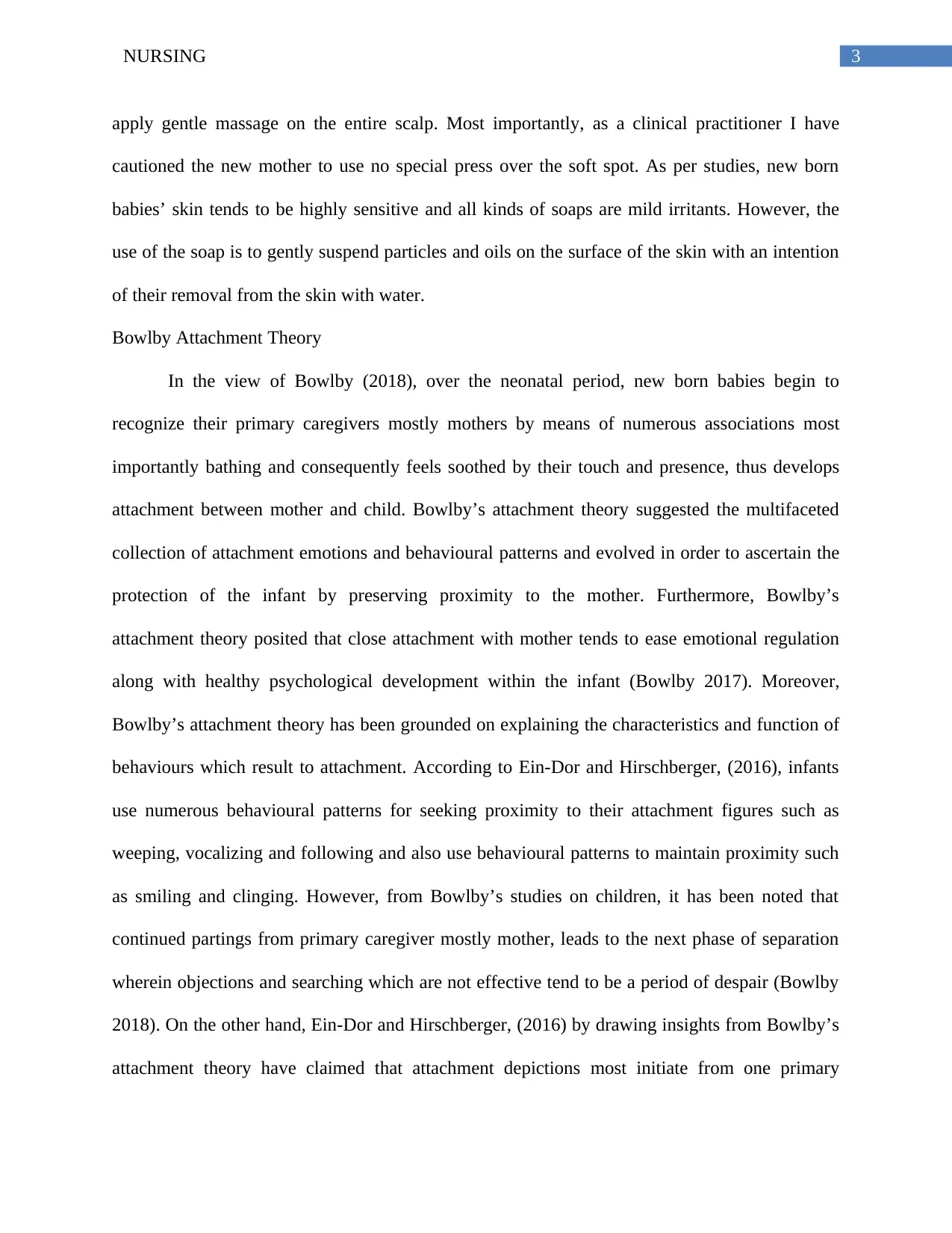
3NURSING
apply gentle massage on the entire scalp. Most importantly, as a clinical practitioner I have
cautioned the new mother to use no special press over the soft spot. As per studies, new born
babies’ skin tends to be highly sensitive and all kinds of soaps are mild irritants. However, the
use of the soap is to gently suspend particles and oils on the surface of the skin with an intention
of their removal from the skin with water.
Bowlby Attachment Theory
In the view of Bowlby (2018), over the neonatal period, new born babies begin to
recognize their primary caregivers mostly mothers by means of numerous associations most
importantly bathing and consequently feels soothed by their touch and presence, thus develops
attachment between mother and child. Bowlby’s attachment theory suggested the multifaceted
collection of attachment emotions and behavioural patterns and evolved in order to ascertain the
protection of the infant by preserving proximity to the mother. Furthermore, Bowlby’s
attachment theory posited that close attachment with mother tends to ease emotional regulation
along with healthy psychological development within the infant (Bowlby 2017). Moreover,
Bowlby’s attachment theory has been grounded on explaining the characteristics and function of
behaviours which result to attachment. According to Ein-Dor and Hirschberger, (2016), infants
use numerous behavioural patterns for seeking proximity to their attachment figures such as
weeping, vocalizing and following and also use behavioural patterns to maintain proximity such
as smiling and clinging. However, from Bowlby’s studies on children, it has been noted that
continued partings from primary caregiver mostly mother, leads to the next phase of separation
wherein objections and searching which are not effective tend to be a period of despair (Bowlby
2018). On the other hand, Ein-Dor and Hirschberger, (2016) by drawing insights from Bowlby’s
attachment theory have claimed that attachment depictions most initiate from one primary
apply gentle massage on the entire scalp. Most importantly, as a clinical practitioner I have
cautioned the new mother to use no special press over the soft spot. As per studies, new born
babies’ skin tends to be highly sensitive and all kinds of soaps are mild irritants. However, the
use of the soap is to gently suspend particles and oils on the surface of the skin with an intention
of their removal from the skin with water.
Bowlby Attachment Theory
In the view of Bowlby (2018), over the neonatal period, new born babies begin to
recognize their primary caregivers mostly mothers by means of numerous associations most
importantly bathing and consequently feels soothed by their touch and presence, thus develops
attachment between mother and child. Bowlby’s attachment theory suggested the multifaceted
collection of attachment emotions and behavioural patterns and evolved in order to ascertain the
protection of the infant by preserving proximity to the mother. Furthermore, Bowlby’s
attachment theory posited that close attachment with mother tends to ease emotional regulation
along with healthy psychological development within the infant (Bowlby 2017). Moreover,
Bowlby’s attachment theory has been grounded on explaining the characteristics and function of
behaviours which result to attachment. According to Ein-Dor and Hirschberger, (2016), infants
use numerous behavioural patterns for seeking proximity to their attachment figures such as
weeping, vocalizing and following and also use behavioural patterns to maintain proximity such
as smiling and clinging. However, from Bowlby’s studies on children, it has been noted that
continued partings from primary caregiver mostly mother, leads to the next phase of separation
wherein objections and searching which are not effective tend to be a period of despair (Bowlby
2018). On the other hand, Ein-Dor and Hirschberger, (2016) by drawing insights from Bowlby’s
attachment theory have claimed that attachment depictions most initiate from one primary
Paraphrase This Document
Need a fresh take? Get an instant paraphrase of this document with our AI Paraphraser
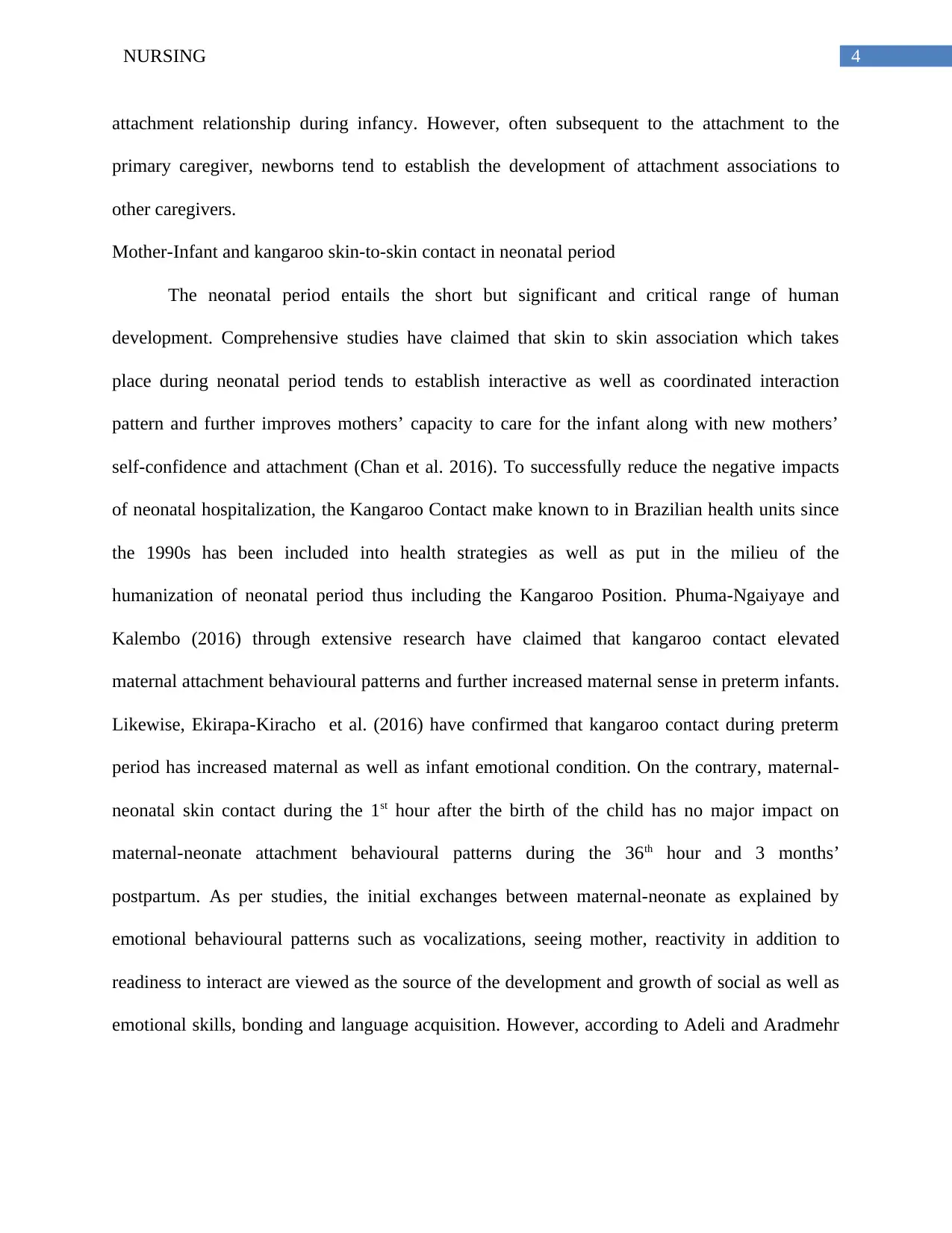
4NURSING
attachment relationship during infancy. However, often subsequent to the attachment to the
primary caregiver, newborns tend to establish the development of attachment associations to
other caregivers.
Mother-Infant and kangaroo skin-to-skin contact in neonatal period
The neonatal period entails the short but significant and critical range of human
development. Comprehensive studies have claimed that skin to skin association which takes
place during neonatal period tends to establish interactive as well as coordinated interaction
pattern and further improves mothers’ capacity to care for the infant along with new mothers’
self-confidence and attachment (Chan et al. 2016). To successfully reduce the negative impacts
of neonatal hospitalization, the Kangaroo Contact make known to in Brazilian health units since
the 1990s has been included into health strategies as well as put in the milieu of the
humanization of neonatal period thus including the Kangaroo Position. Phuma-Ngaiyaye and
Kalembo (2016) through extensive research have claimed that kangaroo contact elevated
maternal attachment behavioural patterns and further increased maternal sense in preterm infants.
Likewise, Ekirapa-Kiracho et al. (2016) have confirmed that kangaroo contact during preterm
period has increased maternal as well as infant emotional condition. On the contrary, maternal-
neonatal skin contact during the 1st hour after the birth of the child has no major impact on
maternal-neonate attachment behavioural patterns during the 36th hour and 3 months’
postpartum. As per studies, the initial exchanges between maternal-neonate as explained by
emotional behavioural patterns such as vocalizations, seeing mother, reactivity in addition to
readiness to interact are viewed as the source of the development and growth of social as well as
emotional skills, bonding and language acquisition. However, according to Adeli and Aradmehr
attachment relationship during infancy. However, often subsequent to the attachment to the
primary caregiver, newborns tend to establish the development of attachment associations to
other caregivers.
Mother-Infant and kangaroo skin-to-skin contact in neonatal period
The neonatal period entails the short but significant and critical range of human
development. Comprehensive studies have claimed that skin to skin association which takes
place during neonatal period tends to establish interactive as well as coordinated interaction
pattern and further improves mothers’ capacity to care for the infant along with new mothers’
self-confidence and attachment (Chan et al. 2016). To successfully reduce the negative impacts
of neonatal hospitalization, the Kangaroo Contact make known to in Brazilian health units since
the 1990s has been included into health strategies as well as put in the milieu of the
humanization of neonatal period thus including the Kangaroo Position. Phuma-Ngaiyaye and
Kalembo (2016) through extensive research have claimed that kangaroo contact elevated
maternal attachment behavioural patterns and further increased maternal sense in preterm infants.
Likewise, Ekirapa-Kiracho et al. (2016) have confirmed that kangaroo contact during preterm
period has increased maternal as well as infant emotional condition. On the contrary, maternal-
neonatal skin contact during the 1st hour after the birth of the child has no major impact on
maternal-neonate attachment behavioural patterns during the 36th hour and 3 months’
postpartum. As per studies, the initial exchanges between maternal-neonate as explained by
emotional behavioural patterns such as vocalizations, seeing mother, reactivity in addition to
readiness to interact are viewed as the source of the development and growth of social as well as
emotional skills, bonding and language acquisition. However, according to Adeli and Aradmehr
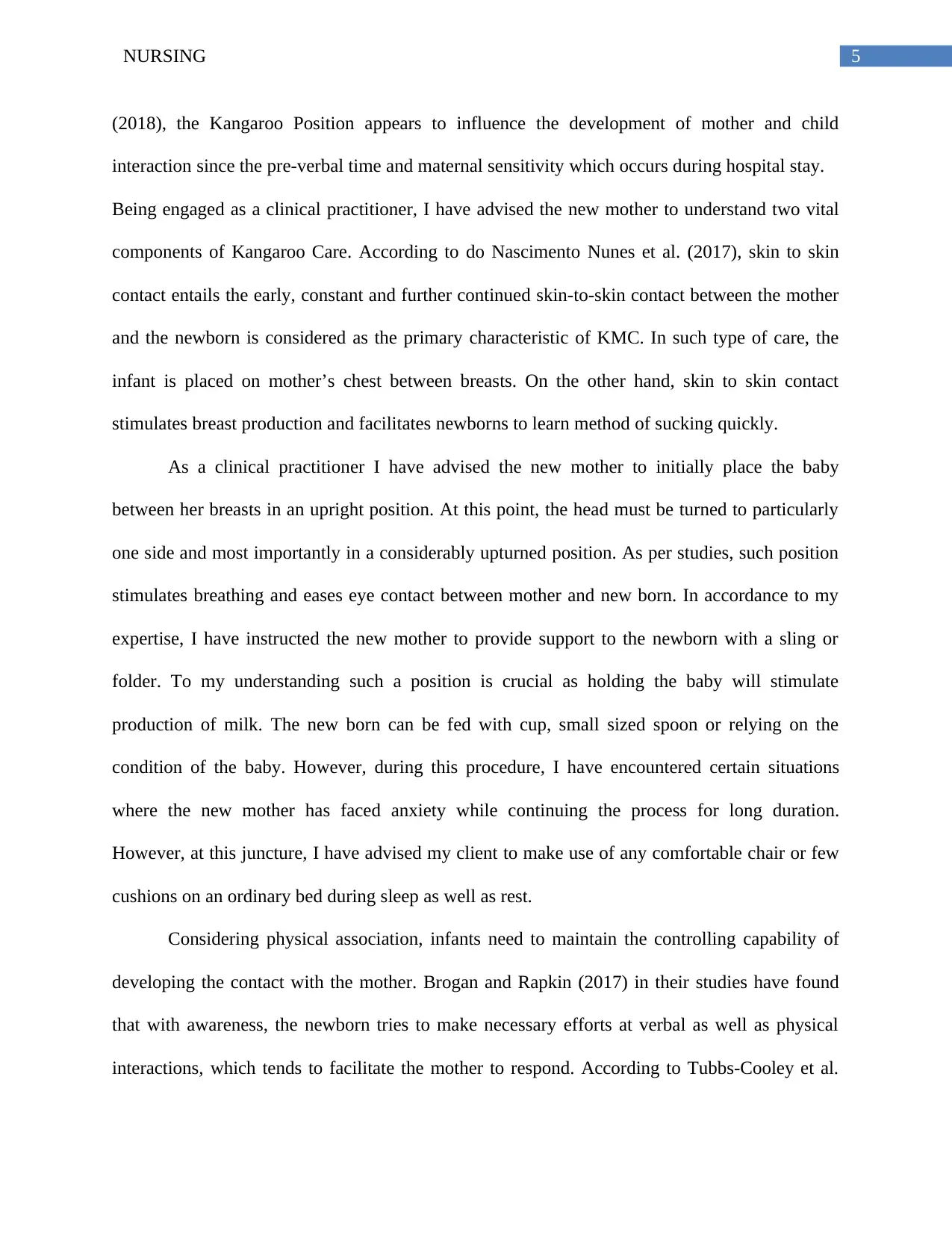
5NURSING
(2018), the Kangaroo Position appears to influence the development of mother and child
interaction since the pre-verbal time and maternal sensitivity which occurs during hospital stay.
Being engaged as a clinical practitioner, I have advised the new mother to understand two vital
components of Kangaroo Care. According to do Nascimento Nunes et al. (2017), skin to skin
contact entails the early, constant and further continued skin-to-skin contact between the mother
and the newborn is considered as the primary characteristic of KMC. In such type of care, the
infant is placed on mother’s chest between breasts. On the other hand, skin to skin contact
stimulates breast production and facilitates newborns to learn method of sucking quickly.
As a clinical practitioner I have advised the new mother to initially place the baby
between her breasts in an upright position. At this point, the head must be turned to particularly
one side and most importantly in a considerably upturned position. As per studies, such position
stimulates breathing and eases eye contact between mother and new born. In accordance to my
expertise, I have instructed the new mother to provide support to the newborn with a sling or
folder. To my understanding such a position is crucial as holding the baby will stimulate
production of milk. The new born can be fed with cup, small sized spoon or relying on the
condition of the baby. However, during this procedure, I have encountered certain situations
where the new mother has faced anxiety while continuing the process for long duration.
However, at this juncture, I have advised my client to make use of any comfortable chair or few
cushions on an ordinary bed during sleep as well as rest.
Considering physical association, infants need to maintain the controlling capability of
developing the contact with the mother. Brogan and Rapkin (2017) in their studies have found
that with awareness, the newborn tries to make necessary efforts at verbal as well as physical
interactions, which tends to facilitate the mother to respond. According to Tubbs‐Cooley et al.
(2018), the Kangaroo Position appears to influence the development of mother and child
interaction since the pre-verbal time and maternal sensitivity which occurs during hospital stay.
Being engaged as a clinical practitioner, I have advised the new mother to understand two vital
components of Kangaroo Care. According to do Nascimento Nunes et al. (2017), skin to skin
contact entails the early, constant and further continued skin-to-skin contact between the mother
and the newborn is considered as the primary characteristic of KMC. In such type of care, the
infant is placed on mother’s chest between breasts. On the other hand, skin to skin contact
stimulates breast production and facilitates newborns to learn method of sucking quickly.
As a clinical practitioner I have advised the new mother to initially place the baby
between her breasts in an upright position. At this point, the head must be turned to particularly
one side and most importantly in a considerably upturned position. As per studies, such position
stimulates breathing and eases eye contact between mother and new born. In accordance to my
expertise, I have instructed the new mother to provide support to the newborn with a sling or
folder. To my understanding such a position is crucial as holding the baby will stimulate
production of milk. The new born can be fed with cup, small sized spoon or relying on the
condition of the baby. However, during this procedure, I have encountered certain situations
where the new mother has faced anxiety while continuing the process for long duration.
However, at this juncture, I have advised my client to make use of any comfortable chair or few
cushions on an ordinary bed during sleep as well as rest.
Considering physical association, infants need to maintain the controlling capability of
developing the contact with the mother. Brogan and Rapkin (2017) in their studies have found
that with awareness, the newborn tries to make necessary efforts at verbal as well as physical
interactions, which tends to facilitate the mother to respond. According to Tubbs‐Cooley et al.
⊘ This is a preview!⊘
Do you want full access?
Subscribe today to unlock all pages.

Trusted by 1+ million students worldwide
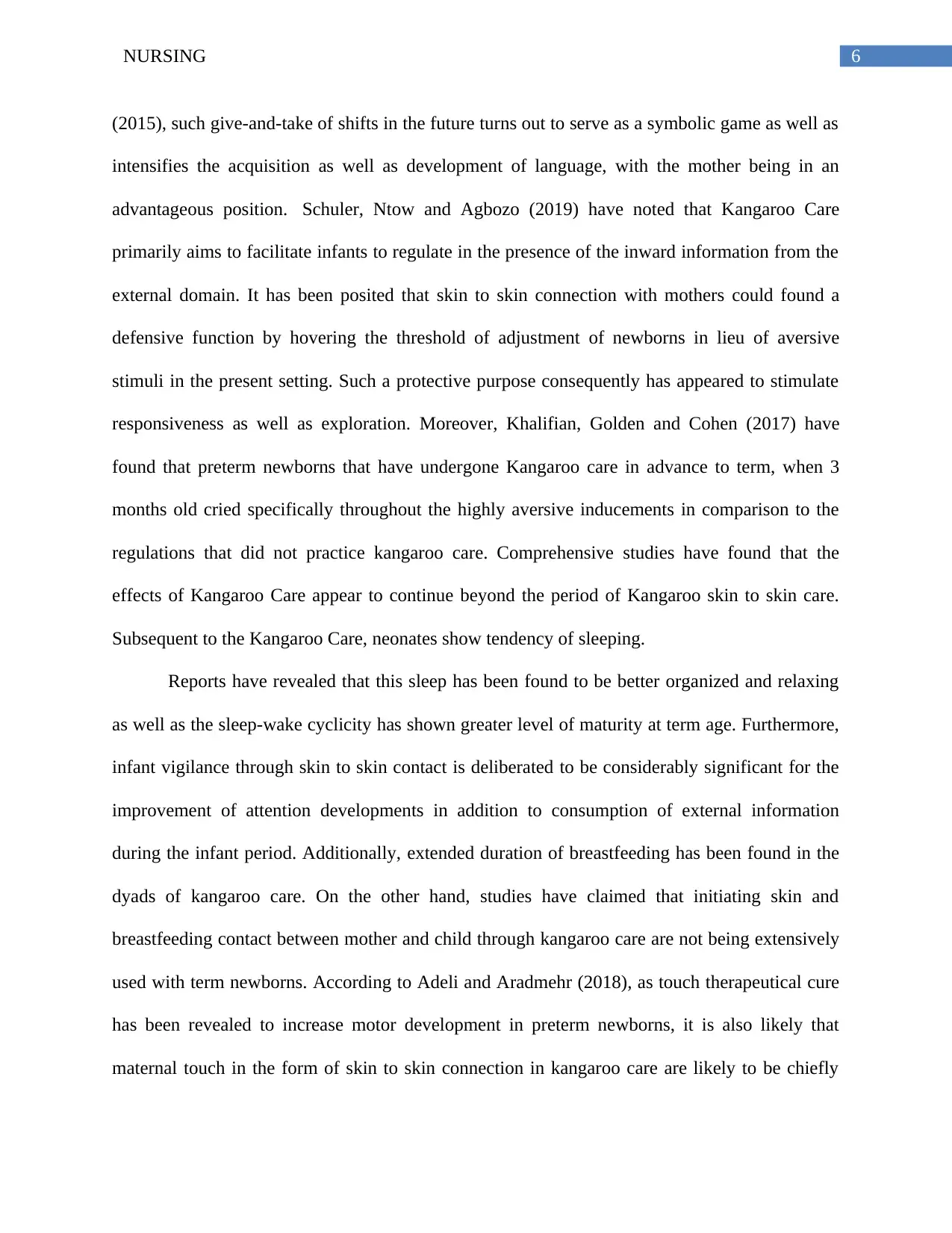
6NURSING
(2015), such give-and-take of shifts in the future turns out to serve as a symbolic game as well as
intensifies the acquisition as well as development of language, with the mother being in an
advantageous position. Schuler, Ntow and Agbozo (2019) have noted that Kangaroo Care
primarily aims to facilitate infants to regulate in the presence of the inward information from the
external domain. It has been posited that skin to skin connection with mothers could found a
defensive function by hovering the threshold of adjustment of newborns in lieu of aversive
stimuli in the present setting. Such a protective purpose consequently has appeared to stimulate
responsiveness as well as exploration. Moreover, Khalifian, Golden and Cohen (2017) have
found that preterm newborns that have undergone Kangaroo care in advance to term, when 3
months old cried specifically throughout the highly aversive inducements in comparison to the
regulations that did not practice kangaroo care. Comprehensive studies have found that the
effects of Kangaroo Care appear to continue beyond the period of Kangaroo skin to skin care.
Subsequent to the Kangaroo Care, neonates show tendency of sleeping.
Reports have revealed that this sleep has been found to be better organized and relaxing
as well as the sleep-wake cyclicity has shown greater level of maturity at term age. Furthermore,
infant vigilance through skin to skin contact is deliberated to be considerably significant for the
improvement of attention developments in addition to consumption of external information
during the infant period. Additionally, extended duration of breastfeeding has been found in the
dyads of kangaroo care. On the other hand, studies have claimed that initiating skin and
breastfeeding contact between mother and child through kangaroo care are not being extensively
used with term newborns. According to Adeli and Aradmehr (2018), as touch therapeutical cure
has been revealed to increase motor development in preterm newborns, it is also likely that
maternal touch in the form of skin to skin connection in kangaroo care are likely to be chiefly
(2015), such give-and-take of shifts in the future turns out to serve as a symbolic game as well as
intensifies the acquisition as well as development of language, with the mother being in an
advantageous position. Schuler, Ntow and Agbozo (2019) have noted that Kangaroo Care
primarily aims to facilitate infants to regulate in the presence of the inward information from the
external domain. It has been posited that skin to skin connection with mothers could found a
defensive function by hovering the threshold of adjustment of newborns in lieu of aversive
stimuli in the present setting. Such a protective purpose consequently has appeared to stimulate
responsiveness as well as exploration. Moreover, Khalifian, Golden and Cohen (2017) have
found that preterm newborns that have undergone Kangaroo care in advance to term, when 3
months old cried specifically throughout the highly aversive inducements in comparison to the
regulations that did not practice kangaroo care. Comprehensive studies have found that the
effects of Kangaroo Care appear to continue beyond the period of Kangaroo skin to skin care.
Subsequent to the Kangaroo Care, neonates show tendency of sleeping.
Reports have revealed that this sleep has been found to be better organized and relaxing
as well as the sleep-wake cyclicity has shown greater level of maturity at term age. Furthermore,
infant vigilance through skin to skin contact is deliberated to be considerably significant for the
improvement of attention developments in addition to consumption of external information
during the infant period. Additionally, extended duration of breastfeeding has been found in the
dyads of kangaroo care. On the other hand, studies have claimed that initiating skin and
breastfeeding contact between mother and child through kangaroo care are not being extensively
used with term newborns. According to Adeli and Aradmehr (2018), as touch therapeutical cure
has been revealed to increase motor development in preterm newborns, it is also likely that
maternal touch in the form of skin to skin connection in kangaroo care are likely to be chiefly
Paraphrase This Document
Need a fresh take? Get an instant paraphrase of this document with our AI Paraphraser
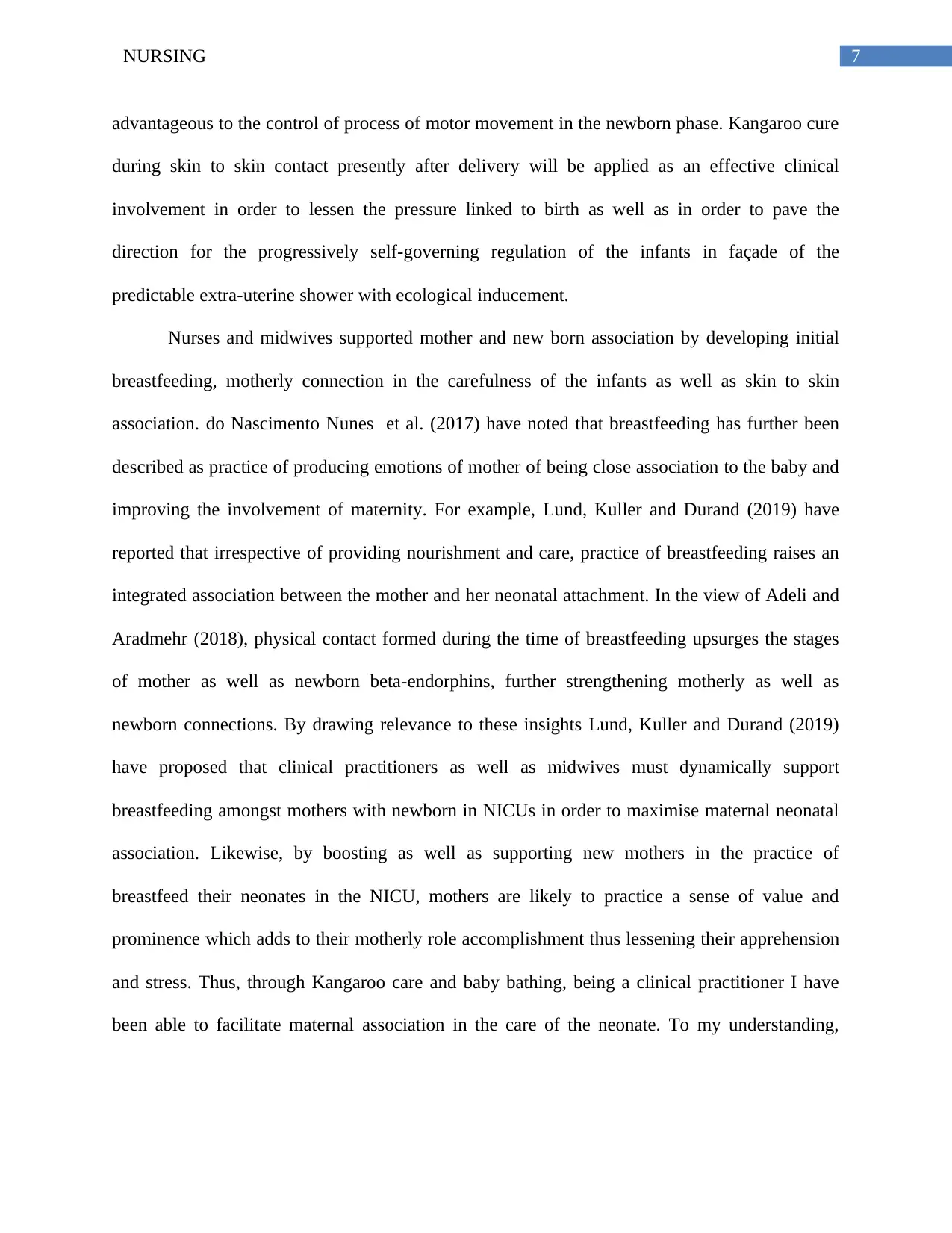
7NURSING
advantageous to the control of process of motor movement in the newborn phase. Kangaroo cure
during skin to skin contact presently after delivery will be applied as an effective clinical
involvement in order to lessen the pressure linked to birth as well as in order to pave the
direction for the progressively self-governing regulation of the infants in façade of the
predictable extra-uterine shower with ecological inducement.
Nurses and midwives supported mother and new born association by developing initial
breastfeeding, motherly connection in the carefulness of the infants as well as skin to skin
association. do Nascimento Nunes et al. (2017) have noted that breastfeeding has further been
described as practice of producing emotions of mother of being close association to the baby and
improving the involvement of maternity. For example, Lund, Kuller and Durand (2019) have
reported that irrespective of providing nourishment and care, practice of breastfeeding raises an
integrated association between the mother and her neonatal attachment. In the view of Adeli and
Aradmehr (2018), physical contact formed during the time of breastfeeding upsurges the stages
of mother as well as newborn beta-endorphins, further strengthening motherly as well as
newborn connections. By drawing relevance to these insights Lund, Kuller and Durand (2019)
have proposed that clinical practitioners as well as midwives must dynamically support
breastfeeding amongst mothers with newborn in NICUs in order to maximise maternal neonatal
association. Likewise, by boosting as well as supporting new mothers in the practice of
breastfeed their neonates in the NICU, mothers are likely to practice a sense of value and
prominence which adds to their motherly role accomplishment thus lessening their apprehension
and stress. Thus, through Kangaroo care and baby bathing, being a clinical practitioner I have
been able to facilitate maternal association in the care of the neonate. To my understanding,
advantageous to the control of process of motor movement in the newborn phase. Kangaroo cure
during skin to skin contact presently after delivery will be applied as an effective clinical
involvement in order to lessen the pressure linked to birth as well as in order to pave the
direction for the progressively self-governing regulation of the infants in façade of the
predictable extra-uterine shower with ecological inducement.
Nurses and midwives supported mother and new born association by developing initial
breastfeeding, motherly connection in the carefulness of the infants as well as skin to skin
association. do Nascimento Nunes et al. (2017) have noted that breastfeeding has further been
described as practice of producing emotions of mother of being close association to the baby and
improving the involvement of maternity. For example, Lund, Kuller and Durand (2019) have
reported that irrespective of providing nourishment and care, practice of breastfeeding raises an
integrated association between the mother and her neonatal attachment. In the view of Adeli and
Aradmehr (2018), physical contact formed during the time of breastfeeding upsurges the stages
of mother as well as newborn beta-endorphins, further strengthening motherly as well as
newborn connections. By drawing relevance to these insights Lund, Kuller and Durand (2019)
have proposed that clinical practitioners as well as midwives must dynamically support
breastfeeding amongst mothers with newborn in NICUs in order to maximise maternal neonatal
association. Likewise, by boosting as well as supporting new mothers in the practice of
breastfeed their neonates in the NICU, mothers are likely to practice a sense of value and
prominence which adds to their motherly role accomplishment thus lessening their apprehension
and stress. Thus, through Kangaroo care and baby bathing, being a clinical practitioner I have
been able to facilitate maternal association in the care of the neonate. To my understanding,
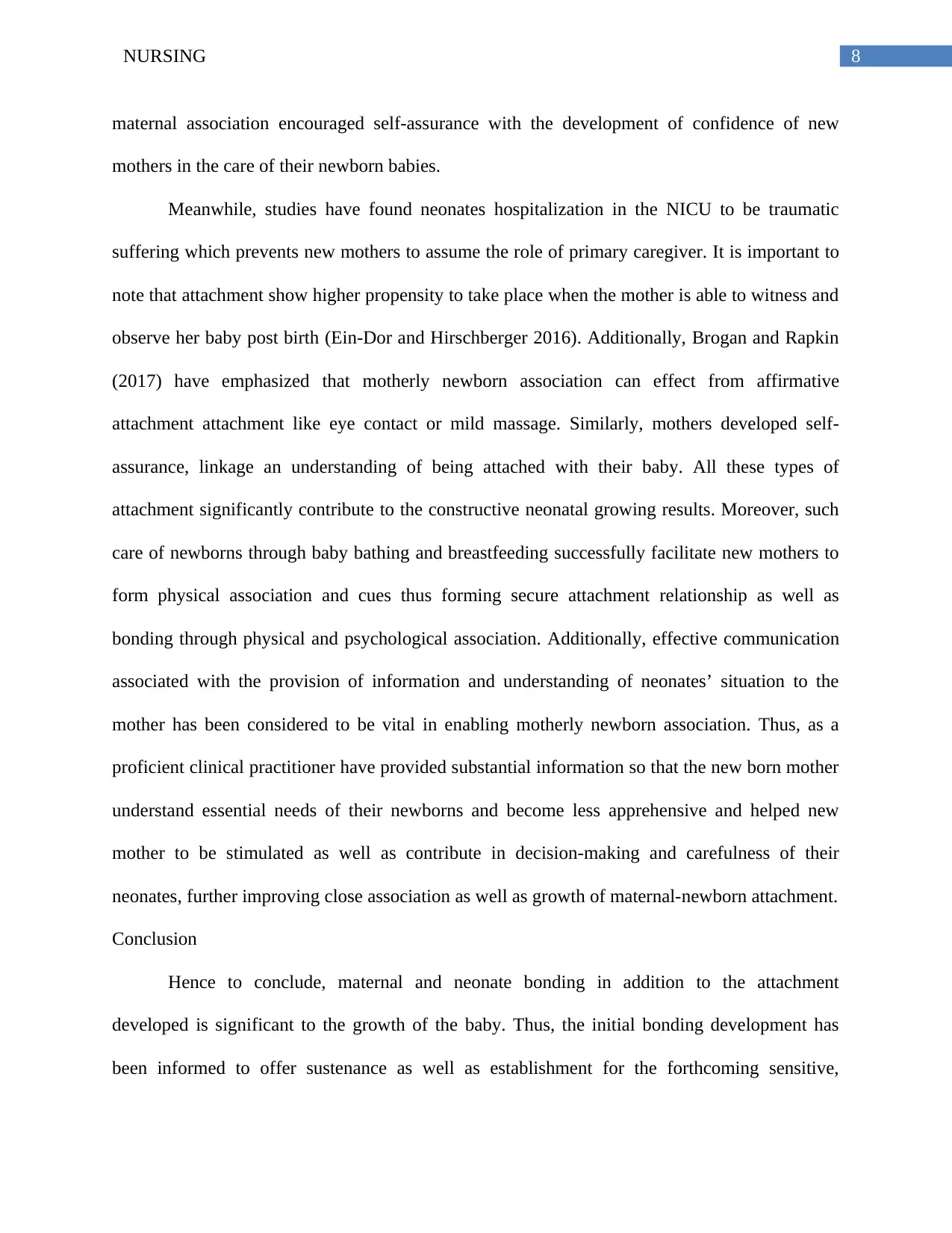
8NURSING
maternal association encouraged self-assurance with the development of confidence of new
mothers in the care of their newborn babies.
Meanwhile, studies have found neonates hospitalization in the NICU to be traumatic
suffering which prevents new mothers to assume the role of primary caregiver. It is important to
note that attachment show higher propensity to take place when the mother is able to witness and
observe her baby post birth (Ein-Dor and Hirschberger 2016). Additionally, Brogan and Rapkin
(2017) have emphasized that motherly newborn association can effect from affirmative
attachment attachment like eye contact or mild massage. Similarly, mothers developed self-
assurance, linkage an understanding of being attached with their baby. All these types of
attachment significantly contribute to the constructive neonatal growing results. Moreover, such
care of newborns through baby bathing and breastfeeding successfully facilitate new mothers to
form physical association and cues thus forming secure attachment relationship as well as
bonding through physical and psychological association. Additionally, effective communication
associated with the provision of information and understanding of neonates’ situation to the
mother has been considered to be vital in enabling motherly newborn association. Thus, as a
proficient clinical practitioner have provided substantial information so that the new born mother
understand essential needs of their newborns and become less apprehensive and helped new
mother to be stimulated as well as contribute in decision-making and carefulness of their
neonates, further improving close association as well as growth of maternal-newborn attachment.
Conclusion
Hence to conclude, maternal and neonate bonding in addition to the attachment
developed is significant to the growth of the baby. Thus, the initial bonding development has
been informed to offer sustenance as well as establishment for the forthcoming sensitive,
maternal association encouraged self-assurance with the development of confidence of new
mothers in the care of their newborn babies.
Meanwhile, studies have found neonates hospitalization in the NICU to be traumatic
suffering which prevents new mothers to assume the role of primary caregiver. It is important to
note that attachment show higher propensity to take place when the mother is able to witness and
observe her baby post birth (Ein-Dor and Hirschberger 2016). Additionally, Brogan and Rapkin
(2017) have emphasized that motherly newborn association can effect from affirmative
attachment attachment like eye contact or mild massage. Similarly, mothers developed self-
assurance, linkage an understanding of being attached with their baby. All these types of
attachment significantly contribute to the constructive neonatal growing results. Moreover, such
care of newborns through baby bathing and breastfeeding successfully facilitate new mothers to
form physical association and cues thus forming secure attachment relationship as well as
bonding through physical and psychological association. Additionally, effective communication
associated with the provision of information and understanding of neonates’ situation to the
mother has been considered to be vital in enabling motherly newborn association. Thus, as a
proficient clinical practitioner have provided substantial information so that the new born mother
understand essential needs of their newborns and become less apprehensive and helped new
mother to be stimulated as well as contribute in decision-making and carefulness of their
neonates, further improving close association as well as growth of maternal-newborn attachment.
Conclusion
Hence to conclude, maternal and neonate bonding in addition to the attachment
developed is significant to the growth of the baby. Thus, the initial bonding development has
been informed to offer sustenance as well as establishment for the forthcoming sensitive,
⊘ This is a preview!⊘
Do you want full access?
Subscribe today to unlock all pages.

Trusted by 1+ million students worldwide
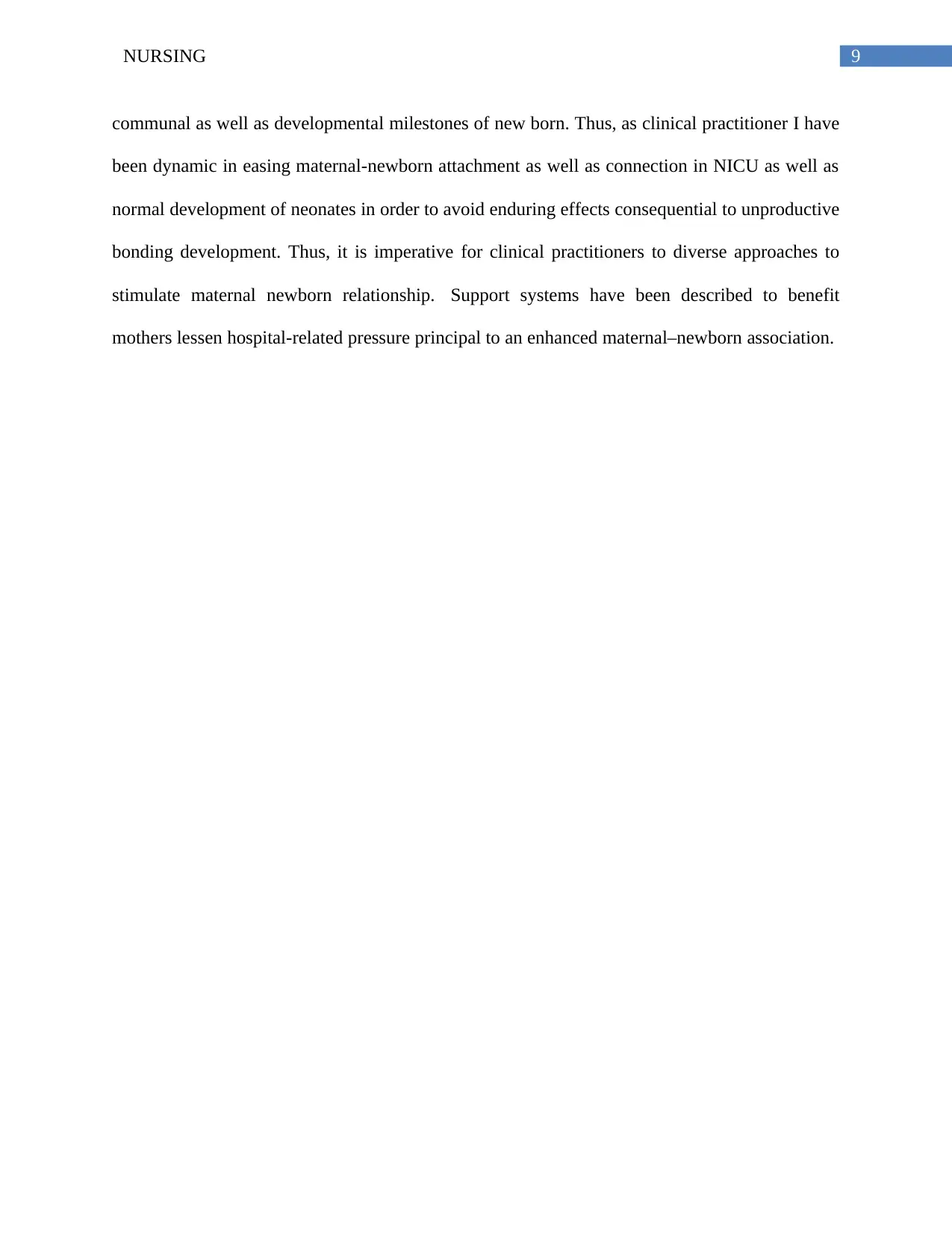
9NURSING
communal as well as developmental milestones of new born. Thus, as clinical practitioner I have
been dynamic in easing maternal-newborn attachment as well as connection in NICU as well as
normal development of neonates in order to avoid enduring effects consequential to unproductive
bonding development. Thus, it is imperative for clinical practitioners to diverse approaches to
stimulate maternal newborn relationship. Support systems have been described to benefit
mothers lessen hospital-related pressure principal to an enhanced maternal–newborn association.
communal as well as developmental milestones of new born. Thus, as clinical practitioner I have
been dynamic in easing maternal-newborn attachment as well as connection in NICU as well as
normal development of neonates in order to avoid enduring effects consequential to unproductive
bonding development. Thus, it is imperative for clinical practitioners to diverse approaches to
stimulate maternal newborn relationship. Support systems have been described to benefit
mothers lessen hospital-related pressure principal to an enhanced maternal–newborn association.
Paraphrase This Document
Need a fresh take? Get an instant paraphrase of this document with our AI Paraphraser
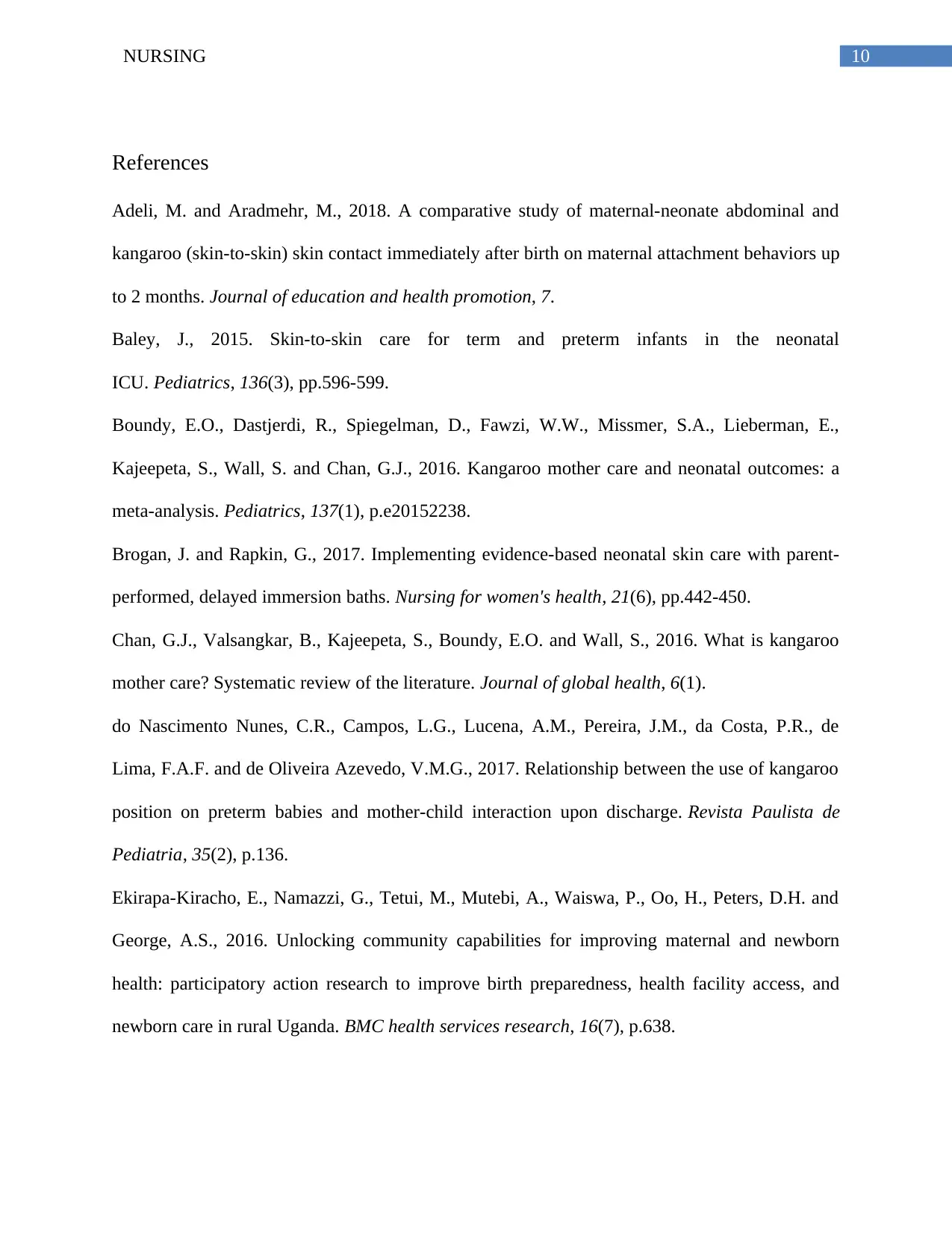
10NURSING
References
Adeli, M. and Aradmehr, M., 2018. A comparative study of maternal-neonate abdominal and
kangaroo (skin-to-skin) skin contact immediately after birth on maternal attachment behaviors up
to 2 months. Journal of education and health promotion, 7.
Baley, J., 2015. Skin-to-skin care for term and preterm infants in the neonatal
ICU. Pediatrics, 136(3), pp.596-599.
Boundy, E.O., Dastjerdi, R., Spiegelman, D., Fawzi, W.W., Missmer, S.A., Lieberman, E.,
Kajeepeta, S., Wall, S. and Chan, G.J., 2016. Kangaroo mother care and neonatal outcomes: a
meta-analysis. Pediatrics, 137(1), p.e20152238.
Brogan, J. and Rapkin, G., 2017. Implementing evidence-based neonatal skin care with parent-
performed, delayed immersion baths. Nursing for women's health, 21(6), pp.442-450.
Chan, G.J., Valsangkar, B., Kajeepeta, S., Boundy, E.O. and Wall, S., 2016. What is kangaroo
mother care? Systematic review of the literature. Journal of global health, 6(1).
do Nascimento Nunes, C.R., Campos, L.G., Lucena, A.M., Pereira, J.M., da Costa, P.R., de
Lima, F.A.F. and de Oliveira Azevedo, V.M.G., 2017. Relationship between the use of kangaroo
position on preterm babies and mother-child interaction upon discharge. Revista Paulista de
Pediatria, 35(2), p.136.
Ekirapa-Kiracho, E., Namazzi, G., Tetui, M., Mutebi, A., Waiswa, P., Oo, H., Peters, D.H. and
George, A.S., 2016. Unlocking community capabilities for improving maternal and newborn
health: participatory action research to improve birth preparedness, health facility access, and
newborn care in rural Uganda. BMC health services research, 16(7), p.638.
References
Adeli, M. and Aradmehr, M., 2018. A comparative study of maternal-neonate abdominal and
kangaroo (skin-to-skin) skin contact immediately after birth on maternal attachment behaviors up
to 2 months. Journal of education and health promotion, 7.
Baley, J., 2015. Skin-to-skin care for term and preterm infants in the neonatal
ICU. Pediatrics, 136(3), pp.596-599.
Boundy, E.O., Dastjerdi, R., Spiegelman, D., Fawzi, W.W., Missmer, S.A., Lieberman, E.,
Kajeepeta, S., Wall, S. and Chan, G.J., 2016. Kangaroo mother care and neonatal outcomes: a
meta-analysis. Pediatrics, 137(1), p.e20152238.
Brogan, J. and Rapkin, G., 2017. Implementing evidence-based neonatal skin care with parent-
performed, delayed immersion baths. Nursing for women's health, 21(6), pp.442-450.
Chan, G.J., Valsangkar, B., Kajeepeta, S., Boundy, E.O. and Wall, S., 2016. What is kangaroo
mother care? Systematic review of the literature. Journal of global health, 6(1).
do Nascimento Nunes, C.R., Campos, L.G., Lucena, A.M., Pereira, J.M., da Costa, P.R., de
Lima, F.A.F. and de Oliveira Azevedo, V.M.G., 2017. Relationship between the use of kangaroo
position on preterm babies and mother-child interaction upon discharge. Revista Paulista de
Pediatria, 35(2), p.136.
Ekirapa-Kiracho, E., Namazzi, G., Tetui, M., Mutebi, A., Waiswa, P., Oo, H., Peters, D.H. and
George, A.S., 2016. Unlocking community capabilities for improving maternal and newborn
health: participatory action research to improve birth preparedness, health facility access, and
newborn care in rural Uganda. BMC health services research, 16(7), p.638.
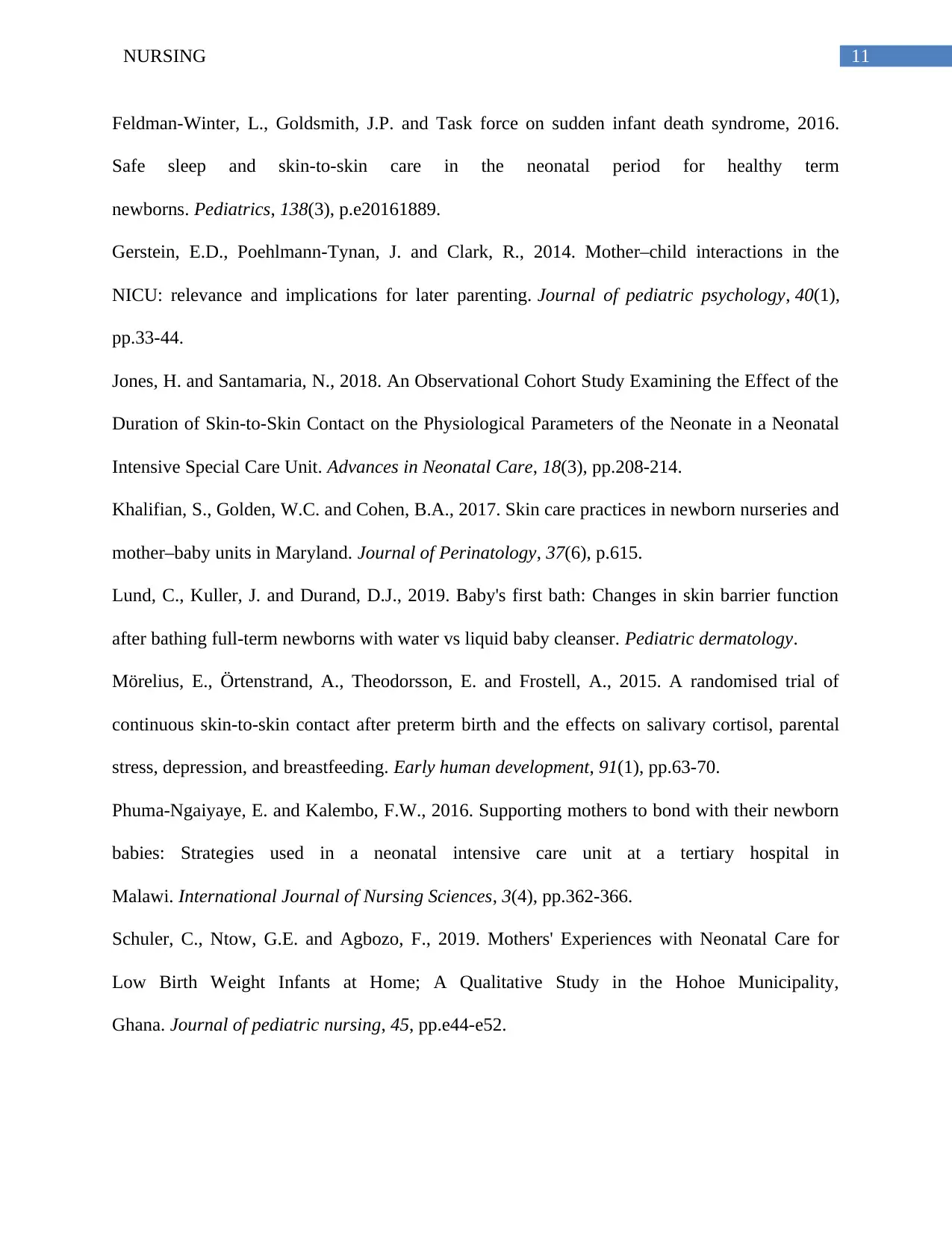
11NURSING
Feldman-Winter, L., Goldsmith, J.P. and Task force on sudden infant death syndrome, 2016.
Safe sleep and skin-to-skin care in the neonatal period for healthy term
newborns. Pediatrics, 138(3), p.e20161889.
Gerstein, E.D., Poehlmann-Tynan, J. and Clark, R., 2014. Mother–child interactions in the
NICU: relevance and implications for later parenting. Journal of pediatric psychology, 40(1),
pp.33-44.
Jones, H. and Santamaria, N., 2018. An Observational Cohort Study Examining the Effect of the
Duration of Skin-to-Skin Contact on the Physiological Parameters of the Neonate in a Neonatal
Intensive Special Care Unit. Advances in Neonatal Care, 18(3), pp.208-214.
Khalifian, S., Golden, W.C. and Cohen, B.A., 2017. Skin care practices in newborn nurseries and
mother–baby units in Maryland. Journal of Perinatology, 37(6), p.615.
Lund, C., Kuller, J. and Durand, D.J., 2019. Baby's first bath: Changes in skin barrier function
after bathing full‐term newborns with water vs liquid baby cleanser. Pediatric dermatology.
Mörelius, E., Örtenstrand, A., Theodorsson, E. and Frostell, A., 2015. A randomised trial of
continuous skin-to-skin contact after preterm birth and the effects on salivary cortisol, parental
stress, depression, and breastfeeding. Early human development, 91(1), pp.63-70.
Phuma-Ngaiyaye, E. and Kalembo, F.W., 2016. Supporting mothers to bond with their newborn
babies: Strategies used in a neonatal intensive care unit at a tertiary hospital in
Malawi. International Journal of Nursing Sciences, 3(4), pp.362-366.
Schuler, C., Ntow, G.E. and Agbozo, F., 2019. Mothers' Experiences with Neonatal Care for
Low Birth Weight Infants at Home; A Qualitative Study in the Hohoe Municipality,
Ghana. Journal of pediatric nursing, 45, pp.e44-e52.
Feldman-Winter, L., Goldsmith, J.P. and Task force on sudden infant death syndrome, 2016.
Safe sleep and skin-to-skin care in the neonatal period for healthy term
newborns. Pediatrics, 138(3), p.e20161889.
Gerstein, E.D., Poehlmann-Tynan, J. and Clark, R., 2014. Mother–child interactions in the
NICU: relevance and implications for later parenting. Journal of pediatric psychology, 40(1),
pp.33-44.
Jones, H. and Santamaria, N., 2018. An Observational Cohort Study Examining the Effect of the
Duration of Skin-to-Skin Contact on the Physiological Parameters of the Neonate in a Neonatal
Intensive Special Care Unit. Advances in Neonatal Care, 18(3), pp.208-214.
Khalifian, S., Golden, W.C. and Cohen, B.A., 2017. Skin care practices in newborn nurseries and
mother–baby units in Maryland. Journal of Perinatology, 37(6), p.615.
Lund, C., Kuller, J. and Durand, D.J., 2019. Baby's first bath: Changes in skin barrier function
after bathing full‐term newborns with water vs liquid baby cleanser. Pediatric dermatology.
Mörelius, E., Örtenstrand, A., Theodorsson, E. and Frostell, A., 2015. A randomised trial of
continuous skin-to-skin contact after preterm birth and the effects on salivary cortisol, parental
stress, depression, and breastfeeding. Early human development, 91(1), pp.63-70.
Phuma-Ngaiyaye, E. and Kalembo, F.W., 2016. Supporting mothers to bond with their newborn
babies: Strategies used in a neonatal intensive care unit at a tertiary hospital in
Malawi. International Journal of Nursing Sciences, 3(4), pp.362-366.
Schuler, C., Ntow, G.E. and Agbozo, F., 2019. Mothers' Experiences with Neonatal Care for
Low Birth Weight Infants at Home; A Qualitative Study in the Hohoe Municipality,
Ghana. Journal of pediatric nursing, 45, pp.e44-e52.
⊘ This is a preview!⊘
Do you want full access?
Subscribe today to unlock all pages.

Trusted by 1+ million students worldwide
1 out of 13
Your All-in-One AI-Powered Toolkit for Academic Success.
+13062052269
info@desklib.com
Available 24*7 on WhatsApp / Email
![[object Object]](/_next/static/media/star-bottom.7253800d.svg)
Unlock your academic potential
Copyright © 2020–2025 A2Z Services. All Rights Reserved. Developed and managed by ZUCOL.